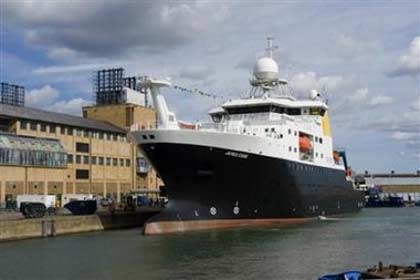Missing: A huge chunk of the earth's crust
(Reuters)Updated: 2007-03-06 08:35
London - A team of British scientists has set sail on a voyage to examine why a huge chunk of the earth's crust is missing, deep under the Atlantic Ocean -- a phenomenon that challenges conventional ideas about how the earth works.
The 20-strong team aims to survey an area some 3,000 to 4,000 metres deep where the mantle -- the deep interior of the earth normally covered by a crust kilometres thick -- is exposed on the sea floor.
Experts describe the hole along the mid-Atlantic ridge as an "open wound" on the ocean floor that has puzzled scientists for the five or so years that its existence has been known because it defies existing tectonic plate theories of evolution.
"We know so little about it," said Bramley Murton, a senior research scientist at Southampton's National Oceanography Center.
"It's a real challenge to our established understanding of what the earth's surface looks like underneath the waves," he told Reuters by telephone from the brand new, hi-tech British research ship RRS James Cook.
Mid ocean ridges are places where new oceanic crust is born, with red-hot lava spewing out along the seafloor.
What scientists are keen to know is whether the crust was ripped away by huge geological faults, or whether it never even developed in the first place.
The primary motivation for the project was to understand how the earth continues to evolve.
"The area that we are looking at is part of a mountain range that spans thousands of square kilometres, but we are beginning to realize that there are probably millions of square kilometres where the ocean floor is missing," Murton said.
The six week mission, led by geophysicist Roger Searle of Durham University and Chris MacLeod of Cardiff University's School of Earth, Ocean and Planetary Sciences, will recover sample cores of rock by drilling into the mantle using a rig lowered on to the sea floor.
Asked if the discovery posed a threat to the environment, Murton replied: "It's not problematic for the earth because it is a natural earth process -- but in terms of knowing how the earth works and how the world is put together it is important."
Murton also said the expedition would shed light on the composition of sea water amongst other initiatives.
Crust formation is a fundamental mechanism of the earth which affects the chemistry of the world's oceans.
|
||
|
||
|
|

